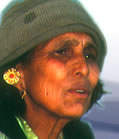 |
 |
||
 |
|||
|
GLOSSARY Nepal glossary |
transcript |
| Section 1 | "Development requires a combination of many elements." Foremost, let us start our conversation from the time before this ropeway was built. When people refer to Lalitpur District, those not familiar with this area invariably think of it as a part of Kathmandu - well connected and well off. But this southern part of Lalitpur District is a remote, mountainous region with no road network. It was difficult for people here to market their agricultural and dairy products. We used to carry the produce on our backs to Mangal Bazaar in Lalitpur. In the beginning we used to collect and sell butter. Later when it was found that solidified milk was more profitable than butter, people in this area began processing milk into solidified cream. But we realised that this led to the destruction of forests. Let's calculate. Processing 500 litres of milk every day would require - one litre needing, on average, one kg - at least 500 kg of firewood. Of course, we also needed fuel wood to cook our food and fodder for our cattle. Additional firewood to boil the milk led us to gradually uproot and burn even tree stumps. With the destruction of forests, natural calamities followed. Landslides occurred and in their wake property - land, houses and farms – was destroyed. In 2038-39 I got the opportunity to be the village chief. We learnt about the Bagmati Watershed Project when we began asking around to find out whom we should approach regarding soil erosion. We presented our problem to them. They first surveyed the area to determine the loss of property because of natural disasters. We held discussions with the Bagmati Watershed Project regarding repairing roads and controlling erosion. We found out during these discussions that in hilly regions, houses and animal sheds are mostly built at a higher level while cultivable lands lie below. During the rainy season, water from the drains, of both houses and cattlesheds, flows down to the fields. In cases where houses are concentrated in a neighbourhood, the flow of water is strong and damages trails, washes away fertile topsoil, and leads to lower crop yields. So we first began controlling the water around our houses. We did this by diverting the flow of unwanted water during the rainy season to rocky and hard areas. We did not dig deep while clearing the terraces in the field, and planted fast growing shrubs and trees along the terrace edges. We were encouraged when these tree branches could later be used as fodder. The terracing of fields helped retain moisture in the soil and checked erosion. Fodder trees on the terrace edges controlled erosion and land productivity increased. To educate us about conservation, technicians from the Bagmati Watershed Project selected a landslide prone area. They built a conservation pond. The excess and fast-flowing water of the rainy season collected in this huge pond. The water flowed out only when the pond became full. And to see that even this would cause no damage, they built crates, wire mesh, and stone stairs [referring to the building of retaining walls and the paving of steep trails]. We planted trees in eroded areas. As a result, even the landslide-prone hill is safe. All this conservation effort and effective management of rain water has led to increased production of vegetables, fruits and dairy products. Productivity increased, but now we had to market and sell the produce. Those of us living one or two hours' walking distance from the motorable road could somehow sell our milk in the city. But many others from our village and the neighbouring villages were not able to carry their milk to the roadhead. So we thought of an alternative. That alternative was this ropeway. If we look at it deeply, this ropeway is far more useful than a motorable road. This does not destroy our environment or our forest. Roads in the mountain get damaged during the rains. It is not always possible to construct roads everywhere, and road construction requires huge investments. We saw this ropeway as a simple, easy and quick alternative and made a request for it. With the terracing of the land, we began cultivating vegetables; productivity increased. We are now getting more money selling milk than butter and other milk products. It is now three years since this ropeway was built at a cost of Rs. 65 lakhs (650, 000). The Bagmati Watershed Project built this ropeway with financial assistance from the European Community. The credit for this goes to the Chief of Bagmati Watershed Project, Mr. Madhukar Upadhaya, a person always concerned about the upliftment of backward hill people, a friend of the poor and the illiterate. He helped us in its construction and in finding markets for our products. This ropeway line is three kilometres long starting at Jhankri Dara. It was built to transport 1000 to 1200 litres of milk from Ikudol, Pyutar and Sankhu and to conserve the firewood needed for processing that milk into solid cream. Twice a week we collect local produce like milk, curd, vegetables, wheat flour, millet, barley and buckwheat flour, corn, goats, chicken and fish and take them to Lalitpur, Lagankhel. We do this on Tuesday for the market day on Wednesday, and on Friday to sell on the following day. As we are members of the District Co-operative Society, we have been provided stalls to sell our produce. We are proud of this market. If this ropeway had not been built and if there were no roads, our pumpkins, cucumbers, pumpkin buds, and other vegetables would have perished and gone to waste. There would have been no source of cash income for us. We cannot grow paddy here. We can only cultivate maize and millet. The yield is enough to feed us for three to four months only; the rest of the year we have to buy rice. Our only source of income was selling milk, butter and other milk products. How could that income be enough in today's world? Now we have education, we need medicines to keep ourselves healthy. We need money every step of the way. In our fathers' time there were no schools; they did not have to send their children to school, they didn't have to pay fees. Thus, even without cash income they could manage their lives. Things now no longer work that way. Even if they are poor, right-thinking parents must educate their children, by working for daily wages if necessary. We realised that we could not do without cash income, and got together and formed a committee. Priority has to be given to women. They suffer more than men do; it is our responsibility to look after their needs. So we decided to do the marketing ourselves. Everything we grew earlier was for our own consumption since we had no market. Once we had the market, we were forced to increase production. What use is the market if we have nothing to sell? We had never planted garlic before. With an assured market, we now cultivate garlic and onions and earn some money. We did not use middlemen but started selling everything directly on our own. We sold whatever the community produced. It was difficult initially to find a market for our goods but produce from Bhattedanda is much sought after now. We sell three hundred litres of curd alone every week. We started slaughtering our goats there and our boys got jobs. We take discarded junk and bring thirty to forty thousand rupees in cash every week and pay for the goods. All houses here were made of thatch before. When there was a fire, a lifetime's earning was destroyed. Now 95 percent of the houses have tin roofs. The place is the same; how did so much improvement take place? All this was possible because of the improved method of cultivation, the ropeway and the road. Awareness has also grown. Nowadays, it seems as if cash itself is life. There is money for the picking all around us but we don't know how to accumulate it. We aren't used to amassing money. We should know how to collect it. We don't have to go anywhere. We don't have to say we are poor; we are just poor in ideas and diligence. We can earn money but for that we need to be enterprising and work hard. Looking at it simply, a ropeway is a thick wire straightened from end to end. It is different from terracing a field but for us both are the same. Development requires a combination of many elements. We had to terrace the fields for higher yields, and then look for a market for our produce. We needed a quick and easy transportation system to take our goods to the market. The market needs fresh products. Spinach from Bhattedanda taken a day late to Lagankhel will not sell. It loses its freshness and dries up. How to get fresh spinach and milk from Ikudol and Bhattedanda to Lagankhel? The answer - a ropeway. All this is a result of improved water management. Anyone who thinks over this seriously will realise the truth. In those days, with contributions from the people we bought seven ropanis [35,000 sq. ft] of land and built the Mahakali Devi Higher Secondary School. But the river cut in on both sides and our school was threatened. We were afraid and appealed to the Watershed Project. "We've lost so much. The labour of so many people is going to go waste, the school built with the sweat of so many people so that their children would receive an education is about to be destroyed." They then placed wire mesh crates in different places. Now that place is lovely and green with trees and plants. This ropeway has a capacity of 300 kg and covers the distance in about 15 to 16 minutes. Roughly, it makes two round trips in an hour. We have five employees. A separate establishment called "Rajjumarg Consumers Committee" has been set up. From its income, we have opened a fixed deposit account for about one lakh two thousand rupees. We charge a transportation fee of 50 paise per kg. We spend some money on stationery, payment of salaries to five workers, diesel and grease, and on repairs and technicians. So far we have managed to operate the system since it was handed over to us by the Watershed Project. We haven't faced any difficulties. Our appeal now is that the ropeway be extended to Lukuni in Makwanpur District, if possible. If it is extended further by about three to four kilometres, it will be easy to transport produce, rations, milk, etc., from Thigini Manthali to Durlung, Pyutar and Asrang. We have already arranged for the marketing. There is no other way to raise the living standard of people in this remote area except by improving agricultural practices and setting up markets. Whatever we have achieved here is because of assistance from the Watershed Project. If support can be extended to others, they, too, will benefit from development. |